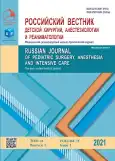Substantiation of organ-preserving surgical treatment of children with nonparasitic spleen cysts
- 作者: Belyaeva A.V.1, Rozinov V.M.1, Polyaev Y.A.2, Belyaeva O.A.3, Bondar Z.M.3
-
隶属关系:
- Institute of Clinical Surgery, Pirogov Russian National Research Medical University
- Russian Children’s Clinical Hospital Pirogov Russian National Research Medical University
- G.N. Speransky Municipal Children’s Clinical Hospital No. 9
- 期: 卷 11, 编号 1 (2021)
- 页面: 17-26
- 栏目: Original Study Articles
- URL: https://journals.rcsi.science/2219-4061/article/view/123487
- DOI: https://doi.org/10.17816/psaic724
- ID: 123487
如何引用文章
全文:
详细
BACKGROUND: The urgency of surgical treatment of children with nonparasitic spleen cysts is determined by the lack of consensus in the professional community, lack of regulatory documents governing the treatment of these patients, frequency of postoperative complications, and unfavorable outcomes.
AIM: This study aimed to improve the efficiency and safety of organ-preserving minimally invasive interventions in children with nonparasitic spleen cysts based on the development of a multifactorial preoperative planning system and substantiation of an algorithm for choosing the optimal surgical strategies.
MATERIALS AND METHODS: Results of surgical treatment of 60 children aged 2–18 yrs with nonparasitic spleen cysts are presented. The spleen cyst volume varied from 3 ml to 1000 ml (Me 50 ml). Preoperative examination included clinical examination, laboratory diagnostics, ultrasonography, computed tomography or magnetic resonance imaging, and angiography of the spleen vessels. The range of surgical technologies included percutaneous puncture (n = 2) and percutaneous puncture drainage (n = 28), followed by sclerosing of the cyst with 96% ethyl alcohol, combined interventions, supplemented by superselective embolization of the spleen arteries feeding the pathological formation (n = 15), laparoscopic fenestrations of cysts with physical de-epithelialization of the inner lining (n = 14), and laparoscopic resection of the spleen pole (n = 1).
RESULTS: The analysis of postoperative complications was carried out depending on the chosen technology of surgical treatment. The follow-up period of 44 patients varied from 6 mon to 3 yrs, which made it possible to reveal the regularities of the reduction of residual cyst cavities and the course of the regeneration processes with an objective assessment of the volumetric characteristics of the spleen. Obliteration of the residual cyst cavities was observed in 79.1% of the patients during the first month after surgery. Subsequent total obliteration of the residual cyst cavities was observed within 1 yr after surgery in 91.7% of children and residual pathological formations persisted in five patients, which accounted for 8.3% of clinical observations. The volume of residual cysts ranged from 1.2% to 10.0% of the initial value, which was regarded as a satisfactory treatment result.
CONCLUSION: Results of a retrospective multivariate analysis made it possible to develop an algorithm for substantiating surgical techniques, providing a radical cure for 95.5% of children with nonparasitic spleen cysts.
作者简介
Anastasiya Belyaeva
Institute of Clinical Surgery, Pirogov Russian National Research Medical University
编辑信件的主要联系方式.
Email: avbelyaeva1@gmail.com
ORCID iD: 0000-0002-4899-904X
SPIN 代码: 1968-4120
researcher
俄罗斯联邦, 1 Ostrovityanova st., Moscow, 117997Vladimir Rozinov
Institute of Clinical Surgery, Pirogov Russian National Research Medical University
Email: rozinov@inbox.ru
ORCID iD: 0000-0002-9491-967X
SPIN 代码: 2770-3752
Dr. Sci. (Med.) Professor
俄罗斯联邦, 1 Ostrovityanova st., Moscow, 117997Yrii Polyaev
Russian Children’s Clinical Hospital Pirogov Russian National Research Medical University
Email: polyaev@inbox.ru
ORCID iD: 0000-0002-9554-6414
Dr. Sci. (Med.), Professor
俄罗斯联邦, 1 Ostrovityanova st., Moscow, 117997Olga Belyaeva
G.N. Speransky Municipal Children’s Clinical Hospital No. 9
Email: belyaeva300@rambler.ru
ORCID iD: 0000-0001-9738-9603
Cand. Sci. (Med.)俄罗斯联邦, 1 Ostrovityanova st., Moscow, 117997
Zoya Bondar
G.N. Speransky Municipal Children’s Clinical Hospital No. 9
Email: z.bondar2018@icloud.com
ORCID iD: 0000-0001-6211-7851
Cand. Sci. (Med.)
俄罗斯联邦, 1 Ostrovityanova st., Moscow, 117997参考
- Zhurilo IP, Litovka VP, Kononuchenko VP, Moskalenko VZ. Nonparasitic cysts of the spleen in children. Surgery. 1993;(8):59–61. (In Russ.)
- Delforge X, Chaussy Y, Borrego P. Management of nonparasitic splenic cysts in children: A French multicenter review of 100 cases. J Pediatr Surg. 2017;52(9):1465–1470. doi: 10.1016/j.jpedsurg.2017.01.054
- Apartsin KA, Belyaeva OA, Grigoriev EG, et al. Spleen injury. V.V. Podkamenev, V.M. Rozinov, E.G. Grigoriev, Yu.A. Kozlov, eds. Moscow: GEOTAR-Media; 2019. P. 72–120. (In Russ.)
- Pate JW, Peters TG, Andrews CP. Postsplenectomy complications. Am J Surg.1985;51(8):437–441.
- Shiryaev AA, Musaev GKh, Kharnas SS, et. Al. Nonparasitic cysts of the spleen. Surgical treatment methods. Bulletin of Surgical Gastroenterology. 2013;(4):26–32. (In Russ.)
- Kubyshkin VA, Ionkin DA. Tumors and cysts of the spleen. Moscow: ID Medpraktika; 2007. P. 91–165. (In Russ.)
- Goktay AY, Secil M, Ozcan MA, et al. Percutaneous Treatment of Congenital Splenic Cysts: Drainage and Sclerotherapy with Polidocanol. Cardiovasc Intervent Radiol. 2006;29(3):469–472. doi: 10.1007/s00270-004-0194-2
- Belyaeva OA, Polyaev YuA, Belyaeva AV, et al. Combined navigational surgical interventions in children with solitary spleen cysts. Russian Bulletin of Pediatric Surgery, Anesthesiology and Reanimatology. 2016;6(1):16–23. (In Russ.)
- Vozgomen OV, Pykov MI, Zaitseva NV, et al. Standard criteria and method for assessing the size of the spleen in children. Doctor.Ru. 2014;11(99):10–14. (In Russ.)
- Trompetas V, Panagopoulos E, Priovolou-Papaevangelou M, Ramantanis G. Giant benign true cyst of the spleen with high serum level of CA 19-9. Eur J Gastroenterol Hepatol. 2002;14(1):85–88. doi: 10.1097/00042737-200201000-00015
- Hirabayashi K, Kawanishi A, Morimachi M, et al. Histological and immunohistochemical analyses of splenic epidermoid cysts. Ann Diagn Pathol. 2019;41:51–56. doi: 10.1016/j.anndiagpath.2019.05.009
补充文件






